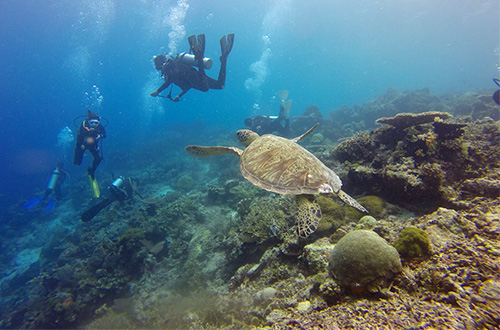Jakarta (Greeners) – Of seven turtle species in the world, Indonesia has six of them, — hawksbill sea turtle (Eretmochelys imbricata), green sea turtle (Chelonia mydas), Olive ridley sea turtle (Lepidochelys olivacea), loggerhead sea turtle (Caretta caretta), leatherback sea turtle (Dermochelys coriacea), and flatback sea turtle (Natator depressus) –, unfortunately, all facing threats.
Imran Amrin, Deputy Director of Coastal and Marine Program, TNC Indonesia, said that there were at least five threats to turtles in Indonesia.
First, land predators threatening the eggs laid in the coastal areas.
READ ALSO: Five Walking Sharks Species Endemic To Indonesia Under Threats
“From surveys in Rote and South Central Timor, of East Nusa Tenggara, we have discovered farm animals, such as pigs, pets such as dogs, and wild animals such as monkeys are threatening these eggs, as much as humans,” said Amrin. “Some of coastal communities in East Nusa Tenggara still uses carapace for accessories, meat and eggs for consumption.”
Furthermore, he said that non regulated sand mining activities, which have led to erosion, making it difficult for turtles to go to the beach and lay eggs.
The third threat is increasing development on coastal areas. Excessive marine spatial planning for development and seaweed farming have forced turtles to lose their breeding spots.
“Then, fourth threat is plastic waste. The death [of turtles] caused by consumption and plastic waste has become world issue, especially in Indonesia. We have no numbers of deaths caused by plastic waste but there are lots evidence that plastic is one of main threat for turtles,” he said in Jakarta, on Thursday (19/1).
READ ALSO: Protecting Ecosystem Lies in Protecting Outside the Area, Minister Says
Lastly, he cited bad conservation practice, including moving the eggs from the nest to breeding centers which would change the temperature needed to hatch. Meanwhile, the length of the breeding, the time of release, numbers of hatchlings, the location, and the release routine will have effects on its safety.
“We see this breeding practice as the last resort. Our priority in turtle conservation is to protect its natural habitat as natural as possible,” he said adding there were varieties of habitat needed by turtles to survive.
Meanwhile, hatchlings’ survival rate is very low, less than 0.01 percent, and the species usually take 15 to 40 years to reach adulthood. Hence, it would take decades for turtles to increase their population.
“Turtle population is under threat though Indonesian government had included all those six species into protected animals based on the 1990 Law on Conservation,” he said.
Reports by Danny Kosasih



















































